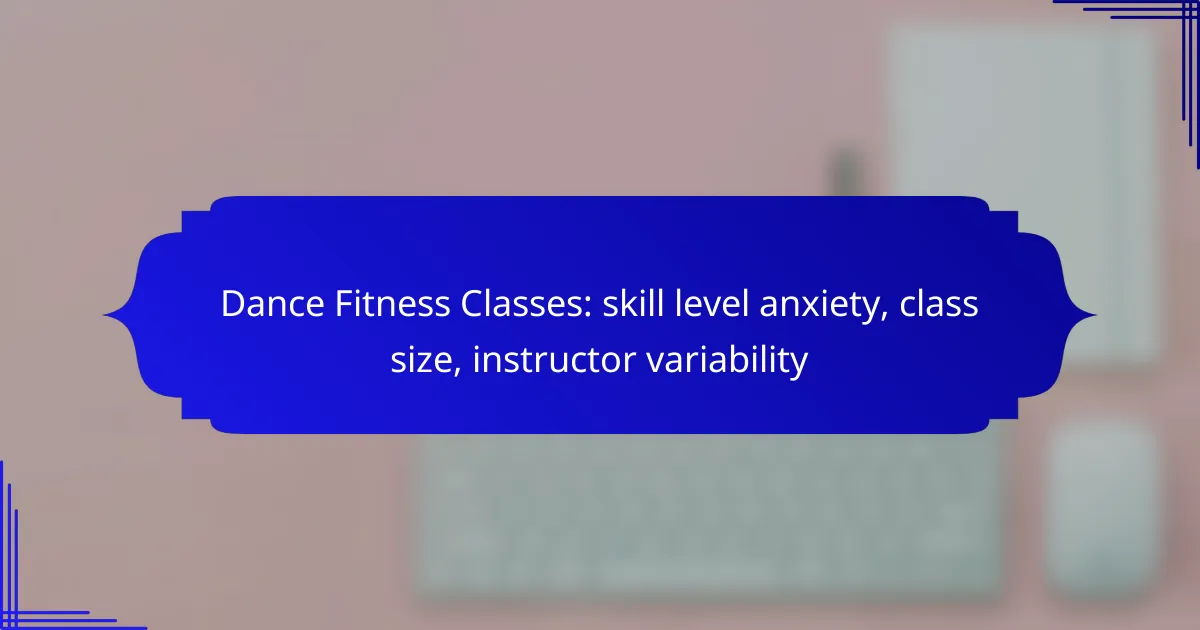When selecting a dance fitness class, it’s important to consider your skill level, class size, and instructor qualifications, as these elements greatly influence your overall experience. Many individuals face anxiety regarding their abilities, which can deter them from fully engaging in classes. Additionally, the size of the class can impact the amount of personal attention you receive, with smaller groups offering more tailored guidance and larger classes fostering a dynamic environment.

How to choose the right dance fitness class in Toronto?
Choosing the right dance fitness class in Toronto involves considering your skill level, the size of the class, and the qualifications of the instructor. These factors can significantly impact your experience and progress in dance fitness.
Consider skill level
Your skill level is crucial when selecting a dance fitness class. Classes typically range from beginner to advanced, and enrolling in a class that matches your ability will enhance your enjoyment and learning. If you’re new to dance, look for introductory classes that focus on basic techniques and movements.
For those with some experience, intermediate classes can offer more challenging routines and techniques. Always check class descriptions and, if possible, attend a trial session to gauge if the class aligns with your current skills.
Evaluate class size
The size of the class can greatly affect your learning experience. Smaller classes, usually with fewer than 15 participants, allow for more personalized attention from the instructor, which can be beneficial for feedback and guidance. In contrast, larger classes may foster a lively atmosphere but can limit individual interaction.
Consider your comfort level with group settings. If you prefer more one-on-one instruction, seek out studios that emphasize smaller class sizes or offer private sessions. Many Toronto studios provide options for both small and larger classes, so you can choose what suits you best.
Research instructor qualifications
The qualifications of the instructor can significantly influence the quality of your dance fitness experience. Look for instructors with certifications in dance and fitness, as well as experience in teaching various skill levels. In Toronto, many reputable studios list their instructors’ credentials on their websites.
Additionally, consider reading reviews or testimonials from former students. A qualified instructor should not only be skilled in dance but also adept at creating a supportive and motivating environment. Engaging with instructors during trial classes can also help you assess their teaching style and compatibility with your learning needs.
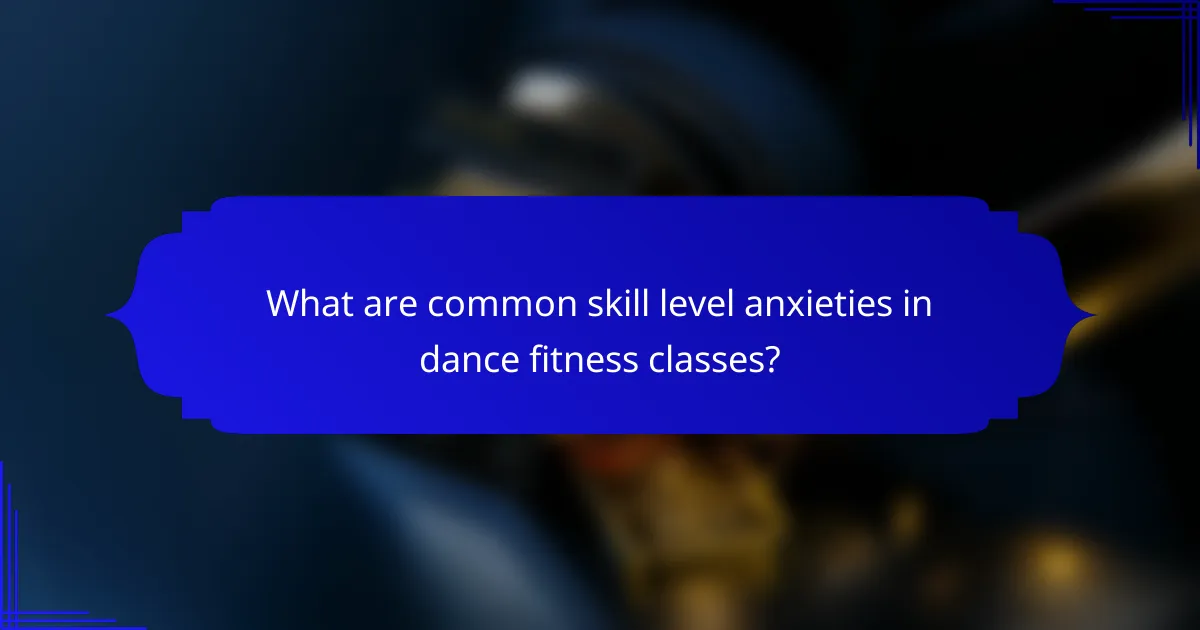
What are common skill level anxieties in dance fitness classes?
Common skill level anxieties in dance fitness classes often stem from fears of inadequacy and concerns about how others perceive one’s abilities. These anxieties can hinder participation and enjoyment, making it essential to address them for a more fulfilling experience.
Fear of not keeping up
The fear of not keeping up with the pace or complexity of a dance fitness class is prevalent among participants. Many worry that they will struggle to follow the instructor or match the energy of more experienced classmates, which can lead to feelings of embarrassment.
To mitigate this fear, consider starting with beginner-friendly classes that emphasize foundational skills. Many studios offer classes labeled as “beginner” or “all levels,” which can help ease the transition into more advanced sessions.
Concerns about judgment from others
Concerns about being judged by fellow participants can create significant anxiety in dance fitness classes. Individuals often fear that their movements will be scrutinized or that they will not perform as well as others, leading to self-consciousness.
To combat these feelings, remember that most participants are focused on their own experience rather than evaluating others. Engaging in classes with a supportive community or friendly instructors can also foster a more inclusive atmosphere, helping to alleviate judgment-related worries.
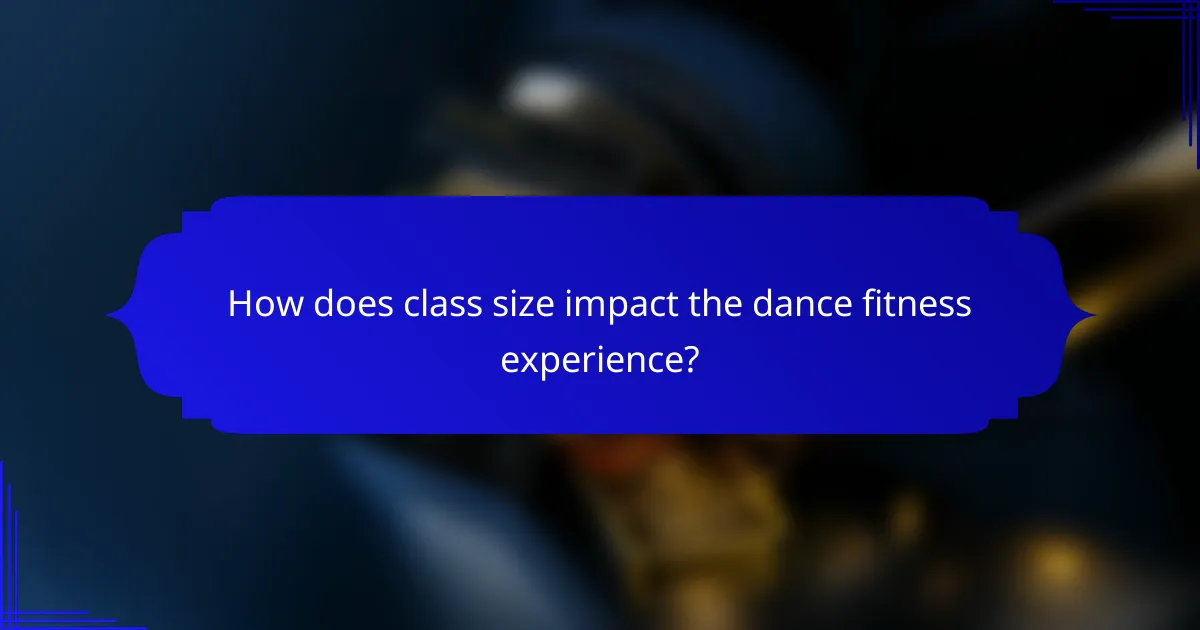
How does class size impact the dance fitness experience?
Class size significantly influences the dance fitness experience by affecting the level of individual attention participants receive and the overall energy in the room. Smaller classes often allow for more personalized guidance, while larger classes can create a vibrant atmosphere that enhances motivation.
More personalized attention in smaller classes
In smaller dance fitness classes, typically consisting of fewer than ten participants, instructors can provide tailored feedback and adjustments to each individual’s technique. This personalized attention helps participants feel more comfortable and confident, especially those who may be new to dance or fitness.
Smaller class sizes also foster a supportive environment where participants can ask questions and receive immediate responses. This interaction can be crucial for building skills and overcoming any anxiety related to performance or fitness levels.
Higher energy and motivation in larger classes
Larger dance fitness classes, often with twenty or more participants, generate a high-energy atmosphere that can be incredibly motivating. The collective enthusiasm and shared experience can push individuals to engage more fully in the workout, often leading to better performance and enjoyment.
However, in larger settings, participants may receive less individual feedback, which can be a drawback for those needing more guidance. It’s essential to find a balance between the energy of a large class and the personalized attention of a smaller one, depending on individual preferences and fitness goals.
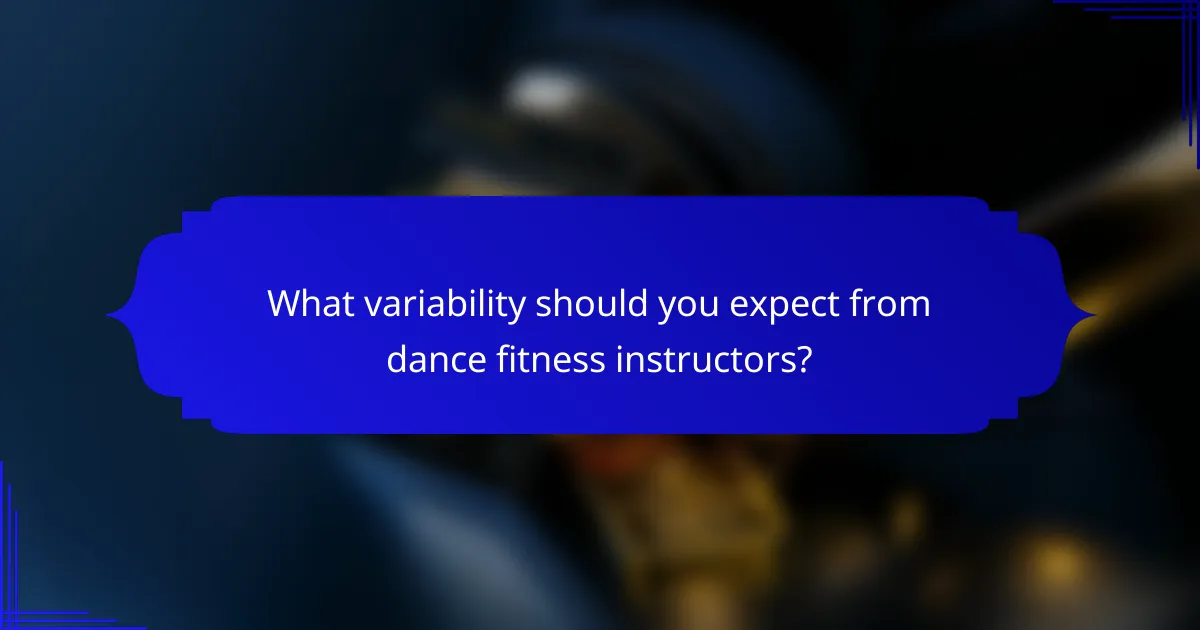
What variability should you expect from dance fitness instructors?
Dance fitness instructors can vary significantly in their teaching methods, experience levels, and class management styles. This variability can affect your overall experience in a class, so understanding these differences can help you choose the right class for your needs.
Different teaching styles
Instructors often employ a range of teaching styles, which can influence how effectively they communicate movements and motivate participants. Some may focus on high-energy, fast-paced routines, while others might emphasize technique and gradual progression. Consider what style resonates with you to enhance your enjoyment and learning.
For instance, if you prefer a more structured approach, look for instructors who provide detailed breakdowns of each move. Conversely, if you thrive in a lively atmosphere, seek out those who encourage improvisation and personal expression during sessions.
Varying levels of experience
The experience level of dance fitness instructors can greatly impact the quality of instruction. Newer instructors may bring fresh energy and innovative routines, but they might lack the depth of knowledge that seasoned professionals possess. Experienced instructors often have a wealth of techniques for modifying movements to accommodate different skill levels.
When selecting a class, consider the instructor’s background. Many studios provide bios or qualifications for their instructors. If you’re a beginner, you might prefer classes led by those with extensive teaching experience who can offer personalized guidance and support.

What prerequisites should you consider before joining a class?
Before joining a dance fitness class, consider your basic fitness level and any previous dance experience. These factors can significantly influence your comfort and enjoyment in the class.
Basic fitness level
Your basic fitness level is crucial when selecting a dance fitness class. If you’re new to exercise, look for beginner-friendly classes that focus on foundational movements and techniques. These classes typically emphasize safety and gradual progression.
For those with a moderate to high fitness level, you might choose more advanced classes that offer greater intensity and complexity. However, ensure that you can handle the physical demands to avoid injury or burnout.
Previous dance experience
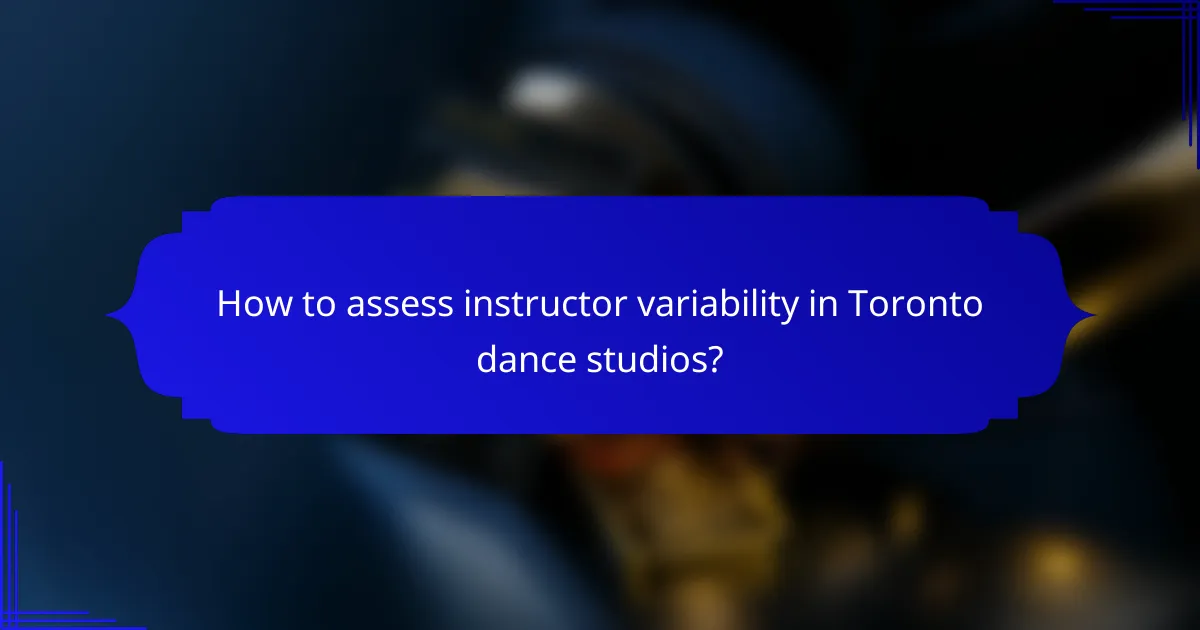
How to assess instructor variability in Toronto dance studios?
To assess instructor variability in Toronto dance studios, consider their teaching styles, experience levels, and student feedback. Variability can significantly affect your learning experience, so it’s crucial to gather insights from multiple sources.
Read reviews on platforms like Yelp
Reading reviews on platforms like Yelp can provide valuable insights into the teaching styles and effectiveness of instructors at various dance studios. Look for comments that mention specific instructors, their approach to teaching, and how they cater to different skill levels.
Pay attention to the overall ratings and the number of reviews. A studio with a high volume of positive feedback is likely to have consistent quality among its instructors. Be cautious of studios with few reviews, as they may not reflect the full range of experiences.
Attend trial classes
Attending trial classes is an effective way to experience instructor variability firsthand. Many Toronto dance studios offer introductory sessions, allowing you to observe different teaching methods and see how instructors interact with students.
During these trial classes, note how instructors provide feedback, their ability to engage students, and how they adapt to various skill levels. This firsthand experience will help you determine which instructors align best with your learning style and comfort level.

What are advanced dance fitness trends in Canada?
Advanced dance fitness trends in Canada focus on enhancing participant engagement and experience through innovative methods. These trends include the integration of technology, personalized class structures, and a growing emphasis on community building.
Integration of technology in classes
The integration of technology in dance fitness classes has transformed how participants engage with workouts. Many studios now use apps and wearable devices to track performance metrics, allowing individuals to monitor their progress in real-time.
Virtual classes and online platforms have also gained popularity, enabling participants to join sessions from home. This flexibility caters to various skill levels and schedules, making dance fitness more accessible to a broader audience.
Additionally, some instructors incorporate interactive elements, such as live polling or gamification, to enhance motivation and competition among participants. This tech-savvy approach can create a more dynamic and enjoyable environment for everyone involved.
